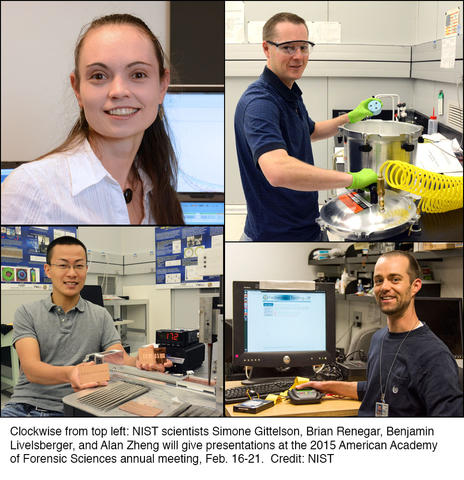
Whether they're analyzing fingerprints at a murder scene or digital clues on a criminal's cell phone, forensic laboratories use research, standards and data from the U.S. National Institute of Standards and Technology (NIST) to obtain the most accurate results possible.
NIST scientists will be presenting their latest advances in forensic science at the American Academy of Forensic Sciences (AAFS) annual meeting in Orlando, Fla., Feb. 16-21, which is expected to draw more than 4,000 attendees. Since 2010, NIST has expanded its efforts in forensic science in response to needs identified in a 2009 National Academy of Sciences report, Strengthening Forensic Science in the United States: A Path Forward.
Meeting attendees will have the opportunity to hear from 19 NIST researchers on an array of topics that support accuracy in forensic science including DNA mixture interpretation, validating digital forensic tools, improving firearms matching, storage of biological evidence and more.
The first public meetings of NIST's Organization of Scientific Area Committees will also take place in Orlando on Feb. 16 and 17. These meetings will include presentation and discussion of priorities for forensic science standards and guidelines for each forensic science discipline. The agenda for these meetings is online.
NIST researchers' poster presentations and talks begin on Wednesday, Feb. 18, and wrap up on Saturday, Feb. 21, as follows:
Wednesday, Feb. 18
11:30 a.m. - 1:00 p.m., Criminalistics Poster Session
- B29 – Effect of Reusing Swipe Materials for Particle Collection Jessica L. Staymates and Matthew E. Staymates, NIST Materials Measurement Science Division
Thursday, Feb. 19
10:30 a.m. – Noon, Jurisprudence Moderated Session
- 10:30 – 10:50 a.m.: F9 – The National Commission on Forensic Science: Status Update by Nelson Santos, Department of Justice, and John Butler, NIST
- 11:30 a.m. – Noon: F12 – Got Forensic Science Standards? — How the Organization of Scientific Area Committees Activities COULD Impact the Courtroom by Mark Stolorow, NIST Special Programs Office
1:00 p.m. – 3:00 p.m., Criminalistics Moderated Session
- 1:30 –1:45 p.m.: B108 – Fingerprint Identification and Error-Rate Estimation Based on the Congruent Matching Cell Method by Wei Chu, NIST Semiconductor and Dimensional Metrology Division
1:40 p.m. – 5:30 p.m., Digital and Multimedia Moderated Session
- 2:20 – 2:40 p.m.: C17 – Cloud Computing Forensic Science Challenges by Martin Herman, NIST Information Technology Laboratory
- 2:40 – 3:00 p.m.: C18 – Federated Testing: Shared Test Materials from the Computer Forensics Tool Testing Program at NIST for Digital Forensics Tool Validation and Shared Test Reports by Benjamin R. Livelsberger, NIST Software and Systems Division
- 5:10 – 5:30 p.m.: C24 – Graphic File Carving Tool Testing by Jenise Reyes-Rodriguez, NIST Software and Systems Division
2:50 p.m. – 5:10 p.m., Criminalistics Moderated Session
- 2:50 – 3:10 p.m.: B94 – Variation in DNA Mixture Interpretation: Observations From NIST Interlaboratory Study Results by Michael Coble, NIST Biomolecular Measurements Division, and John Butler, NIST Special Programs Office
2:30 – 3:45 p.m., General Moderated Session
- 3:15 – 3:30 p.m.: E48 – Ambient Ionization Mass Spectrometric Detection of Homemade Explosives in the Presence of Precursors by Edward Sisco, NIST Materials Measurement Science Division
3:15 p.m. – 5:30 p.m., Criminalistics Moderated Session
- 3:15 – 3:30 p.m.: B114 – Polymer Replication of Reference Bullets Using Advanced Casting and Metal-Coating Techniques by Thomas Renegar, NIST Semiconductor and Dimensional Metrology Division
- 3:30 – 3:45 p.m.: B115 – Reporting Error Rate for Firearm and Tool Mark Identifications in Forensic Science by Junfeng Song, NIST Semiconductor and Dimensional Metrology Division
- 3:45 – 4:00 p.m.: B116 – NIST Reference Ballistic Tool Mark Database for Research and Development of Identification Systems and Confidence Limits by Alan Zheng, NIST Semiconductor and Dimensional Metrology Division
- 4:00 – 4:15 p.m.: B117 – Improved Congruent Matching Cells Method for Optical Images Identification of Cartridge Cases by Mingsi Tong, NIST Semiconductor and Dimensional Metrology Division
Friday, Feb. 20
10:30 a.m. – 1:00 p.m., General Moderated Session
- 10:30 –10:45 a.m.: E61 – Biometric Research Database Catalog: Improving Access to Publicly Available Biometric Data Sets by Shannan Williams, NIST Special Programs Office
1:00 – 2:15 p.m., Multidisciplinary Moderated Session I
- 1:00 – 1:20 p.m.: E67 – Organization of Scientific Area Committees Forensic Science Standards Activities: Helping Each Other and Stimulating the Future John Paul Jones II, NIST Special Programs Office
- 1:20 –1:45 p.m.: E68 – A Step Toward Likelihood Ratios in Pattern Recognition Disciplines by Simone Gittelson, NIST Statistical Engineering Division
1:00 – 2:20 p.m., Jurisprudence Moderated Session
- 1:00 –1:20 p.m.: F37 – Why DNA Interpretation Has Become More Challenging in Recent Years by John Butler, NIST Special Programs Office
- 1:40 –2:00 p.m.: F39 – Biological Evidence Storage and Disposition: A Discussion of Legal Implications, Trends, and Policy Recommendations by Shannan Williams, NIST Special Programs Office
1:00 – 3:15 p.m., Criminalistics Moderated Session
- 1:15 – 1:30 p.m.: B161 – Odorant Measurement and New Materials for Canine Training by William MacCrehan, Chemical Sciences Division
- 2:30 – 2:45 p.m.: B166 – Analysis of Arson Fire Debris by Low Temperature Dynamic Headspace Adsorption Porous Layer Open Tubular (PLOT) Columns Thomas Bruno, NIST Applied Chemicals and Materials Division
Saturday, Feb. 21
8:30 – 10:15 a.m., Criminalistics Moderated Session
- 8:45 – 9:00 a.m.: B189 – Investigating the Use of Illicit Drug Smoke Aerosol Residues as Recoverable Trace Evidence by Julie Bitter, NIST Materials Measurement Science Division
8:30 – 10:00 a.m., Criminalistics Moderated Session
- 9:40 – 10:00 a.m.: B182 – B182 Examination of Rapidly Mutating Y-STR Loci for Increased Resolution of Common Haplotypes Using a Large Multiplex Kit by Michael Coble, NIST Biomolecular Measurements Division

